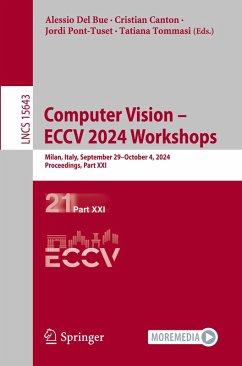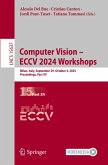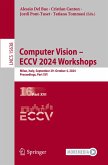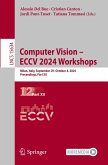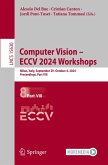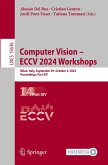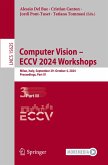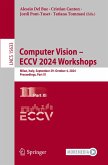Computer Vision - ECCV 2024 Workshops
Milan, Italy, September 29-October 4, 2024, Proceedings, Part XXI
Herausgegeben:Del Bue, Alessio; Canton, Cristian; Pont-Tuset, Jordi; Tommasi, Tatiana
Computer Vision - ECCV 2024 Workshops
Milan, Italy, September 29-October 4, 2024, Proceedings, Part XXI
Herausgegeben:Del Bue, Alessio; Canton, Cristian; Pont-Tuset, Jordi; Tommasi, Tatiana
- Broschiertes Buch
- Merkliste
- Auf die Merkliste
- Bewerten Bewerten
- Teilen
- Produkt teilen
- Produkterinnerung
- Produkterinnerung
The multi-volume set LNCS 15623 until LNCS 15646 constitutes the proceedings of the workshops that were held in conjunction with the 18th European Conference on Computer Vision, ECCV 2024, which took place in Milan, Italy, during September 29 October 4, 2024.
These LNCS volumes contain 574 accepted papers from 53 of the 73 workshops. The list of workshops and distribution of the workshop papers in the LNCS volumes can be found in the preface that is freely accessible online.
Andere Kunden interessierten sich auch für
![Computer Vision - ECCV 2024 Workshops Computer Vision - ECCV 2024 Workshops]() Computer Vision - ECCV 2024 Workshops61,99 €
Computer Vision - ECCV 2024 Workshops61,99 €![Computer Vision - ECCV 2024 Workshops Computer Vision - ECCV 2024 Workshops]() Computer Vision - ECCV 2024 Workshops61,99 €
Computer Vision - ECCV 2024 Workshops61,99 €![Computer Vision - ECCV 2024 Workshops Computer Vision - ECCV 2024 Workshops]() Computer Vision - ECCV 2024 Workshops112,99 €
Computer Vision - ECCV 2024 Workshops112,99 €![Computer Vision - ECCV 2024 Workshops Computer Vision - ECCV 2024 Workshops]() Computer Vision - ECCV 2024 Workshops112,99 €
Computer Vision - ECCV 2024 Workshops112,99 €![Computer Vision - ECCV 2024 Workshops Computer Vision - ECCV 2024 Workshops]() Computer Vision - ECCV 2024 Workshops61,99 €
Computer Vision - ECCV 2024 Workshops61,99 €![Computer Vision - ECCV 2024 Workshops Computer Vision - ECCV 2024 Workshops]() Computer Vision - ECCV 2024 Workshops112,99 €
Computer Vision - ECCV 2024 Workshops112,99 €![Computer Vision - ECCV 2024 Workshops Computer Vision - ECCV 2024 Workshops]() Computer Vision - ECCV 2024 Workshops112,99 €
Computer Vision - ECCV 2024 Workshops112,99 €-
-
-
The multi-volume set LNCS 15623 until LNCS 15646 constitutes the proceedings of the workshops that were held in conjunction with the 18th European Conference on Computer Vision, ECCV 2024, which took place in Milan, Italy, during September 29 October 4, 2024.
These LNCS volumes contain 574 accepted papers from 53 of the 73 workshops. The list of workshops and distribution of the workshop papers in the LNCS volumes can be found in the preface that is freely accessible online.
These LNCS volumes contain 574 accepted papers from 53 of the 73 workshops. The list of workshops and distribution of the workshop papers in the LNCS volumes can be found in the preface that is freely accessible online.
Produktdetails
- Produktdetails
- Lecture Notes in Computer Science 15643
- Verlag: Springer / Springer Nature Switzerland / Springer, Berlin
- Artikelnr. des Verlages: 978-3-031-92647-1
- Seitenzahl: 512
- Erscheinungstermin: 31. Mai 2025
- Englisch
- Abmessung: 235mm x 155mm x 28mm
- Gewicht: 768g
- ISBN-13: 9783031926471
- ISBN-10: 3031926471
- Artikelnr.: 73832236
- Herstellerkennzeichnung
- Springer-Verlag KG
- Sachsenplatz 4-6
- 1201 Wien, AT
- ProductSafety@springernature.com
- Lecture Notes in Computer Science 15643
- Verlag: Springer / Springer Nature Switzerland / Springer, Berlin
- Artikelnr. des Verlages: 978-3-031-92647-1
- Seitenzahl: 512
- Erscheinungstermin: 31. Mai 2025
- Englisch
- Abmessung: 235mm x 155mm x 28mm
- Gewicht: 768g
- ISBN-13: 9783031926471
- ISBN-10: 3031926471
- Artikelnr.: 73832236
- Herstellerkennzeichnung
- Springer-Verlag KG
- Sachsenplatz 4-6
- 1201 Wien, AT
- ProductSafety@springernature.com
FALCON: Fair Active Learning for Content Moderation.- Generalizing Fairness to Generative Language Models via Reformulation of Non-discrimination Criteria.- Beyond the Surface: A Comprehensive Analysis of Implicit Bias in Vision-Language Models.- Fairness of AI Systems in the Legal Context.- DebiasPI: Inference-time Debiasing by Prompt Iteration of a Text-to-Image Generative Model.- Fairness Under Cover: Evaluating the Impact of Occlusions on Demographic Bias in Facial Recognition.- Prompt and Prejudice.- Localization-Guided Supervision for Robust Medical Image Classification by Vision Transformers.- Top-GAP: Integrating Size Priors in CNNs for more Interpretability, Robustness, and Bias Mitigation.- Pruning By Explaining Revisited: Optimizing Attribution Methods to Prune CNNs and Transformers.-
An Investigation on The Position Encoding in Vision-Based Dynamics Prediction.- What could go wrong? Discovering and describing failure modes in computer vision.- Image-guided topic modeling for interpretable privacy classification.- Integrating Local and Global Interpretability for Deep Concept-Based Reasoning Models.- From Flexibility to Manipulation: The Slippery Slope of XAI Evaluation.- Feature Contribution in Monocular Depth Estimation.- Concept-Based Explanations in Computer Vision: Where Are We and Where Could We Go?.- Explanation Alignment: Quantifying the Correctness of Model Reasoning At Scale.- Detect Fake with Fake: Leveraging Synthetic Data-driven Representation
for Synthetic Image Detection.- Incremental and Decremental Continual Learning for Privacy-preserving
Video Recognition.- Exploring Strengths and Weaknesses of Super-Resolution Attack in Deepfake
Detection.- Are CLIP features all you need for Universal Synthetic Image Origin Attribution?.- GLoFool: global enhancements and local perturbations to craft adversarial images.- Evolution of Detection Performance throughout the Online Lifespan of Synthetic Images.- Your diffusion model is an implicit synthetic image detector.- The Phantom Menace: Unmasking Privacy Leakages in Vision-Language
Models.
An Investigation on The Position Encoding in Vision-Based Dynamics Prediction.- What could go wrong? Discovering and describing failure modes in computer vision.- Image-guided topic modeling for interpretable privacy classification.- Integrating Local and Global Interpretability for Deep Concept-Based Reasoning Models.- From Flexibility to Manipulation: The Slippery Slope of XAI Evaluation.- Feature Contribution in Monocular Depth Estimation.- Concept-Based Explanations in Computer Vision: Where Are We and Where Could We Go?.- Explanation Alignment: Quantifying the Correctness of Model Reasoning At Scale.- Detect Fake with Fake: Leveraging Synthetic Data-driven Representation
for Synthetic Image Detection.- Incremental and Decremental Continual Learning for Privacy-preserving
Video Recognition.- Exploring Strengths and Weaknesses of Super-Resolution Attack in Deepfake
Detection.- Are CLIP features all you need for Universal Synthetic Image Origin Attribution?.- GLoFool: global enhancements and local perturbations to craft adversarial images.- Evolution of Detection Performance throughout the Online Lifespan of Synthetic Images.- Your diffusion model is an implicit synthetic image detector.- The Phantom Menace: Unmasking Privacy Leakages in Vision-Language
Models.
FALCON: Fair Active Learning for Content Moderation.- Generalizing Fairness to Generative Language Models via Reformulation of Non-discrimination Criteria.- Beyond the Surface: A Comprehensive Analysis of Implicit Bias in Vision-Language Models.- Fairness of AI Systems in the Legal Context.- DebiasPI: Inference-time Debiasing by Prompt Iteration of a Text-to-Image Generative Model.- Fairness Under Cover: Evaluating the Impact of Occlusions on Demographic Bias in Facial Recognition.- Prompt and Prejudice.- Localization-Guided Supervision for Robust Medical Image Classification by Vision Transformers.- Top-GAP: Integrating Size Priors in CNNs for more Interpretability, Robustness, and Bias Mitigation.- Pruning By Explaining Revisited: Optimizing Attribution Methods to Prune CNNs and Transformers.-
An Investigation on The Position Encoding in Vision-Based Dynamics Prediction.- What could go wrong? Discovering and describing failure modes in computer vision.- Image-guided topic modeling for interpretable privacy classification.- Integrating Local and Global Interpretability for Deep Concept-Based Reasoning Models.- From Flexibility to Manipulation: The Slippery Slope of XAI Evaluation.- Feature Contribution in Monocular Depth Estimation.- Concept-Based Explanations in Computer Vision: Where Are We and Where Could We Go?.- Explanation Alignment: Quantifying the Correctness of Model Reasoning At Scale.- Detect Fake with Fake: Leveraging Synthetic Data-driven Representation
for Synthetic Image Detection.- Incremental and Decremental Continual Learning for Privacy-preserving
Video Recognition.- Exploring Strengths and Weaknesses of Super-Resolution Attack in Deepfake
Detection.- Are CLIP features all you need for Universal Synthetic Image Origin Attribution?.- GLoFool: global enhancements and local perturbations to craft adversarial images.- Evolution of Detection Performance throughout the Online Lifespan of Synthetic Images.- Your diffusion model is an implicit synthetic image detector.- The Phantom Menace: Unmasking Privacy Leakages in Vision-Language
Models.
An Investigation on The Position Encoding in Vision-Based Dynamics Prediction.- What could go wrong? Discovering and describing failure modes in computer vision.- Image-guided topic modeling for interpretable privacy classification.- Integrating Local and Global Interpretability for Deep Concept-Based Reasoning Models.- From Flexibility to Manipulation: The Slippery Slope of XAI Evaluation.- Feature Contribution in Monocular Depth Estimation.- Concept-Based Explanations in Computer Vision: Where Are We and Where Could We Go?.- Explanation Alignment: Quantifying the Correctness of Model Reasoning At Scale.- Detect Fake with Fake: Leveraging Synthetic Data-driven Representation
for Synthetic Image Detection.- Incremental and Decremental Continual Learning for Privacy-preserving
Video Recognition.- Exploring Strengths and Weaknesses of Super-Resolution Attack in Deepfake
Detection.- Are CLIP features all you need for Universal Synthetic Image Origin Attribution?.- GLoFool: global enhancements and local perturbations to craft adversarial images.- Evolution of Detection Performance throughout the Online Lifespan of Synthetic Images.- Your diffusion model is an implicit synthetic image detector.- The Phantom Menace: Unmasking Privacy Leakages in Vision-Language
Models.

